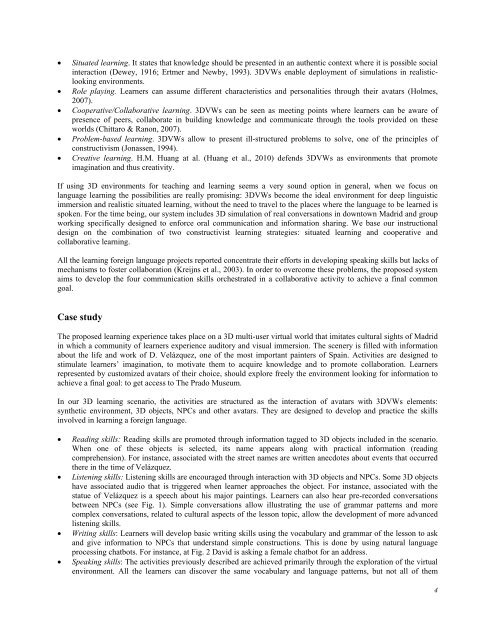October 2011 Volume 14 Number 4 - Educational Technology ...
October 2011 Volume 14 Number 4 - Educational Technology ...
October 2011 Volume 14 Number 4 - Educational Technology ...
You also want an ePaper? Increase the reach of your titles
YUMPU automatically turns print PDFs into web optimized ePapers that Google loves.
Situated learning. It states that knowledge should be presented in an authentic context where it is possible social<br />
interaction (Dewey, 1916; Ertmer and Newby, 1993). 3DVWs enable deployment of simulations in realisticlooking<br />
environments.<br />
Role playing. Learners can assume different characteristics and personalities through their avatars (Holmes,<br />
2007).<br />
Cooperative/Collaborative learning. 3DVWs can be seen as meeting points where learners can be aware of<br />
presence of peers, collaborate in building knowledge and communicate through the tools provided on these<br />
worlds (Chittaro & Ranon, 2007).<br />
Problem-based learning. 3DVWs allow to present ill-structured problems to solve, one of the principles of<br />
constructivism (Jonassen, 1994).<br />
Creative learning. H.M. Huang at al. (Huang et al., 2010) defends 3DVWs as environments that promote<br />
imagination and thus creativity.<br />
If using 3D environments for teaching and learning seems a very sound option in general, when we focus on<br />
language learning the possibilities are really promising: 3DVWs become the ideal environment for deep linguistic<br />
immersion and realistic situated learning, without the need to travel to the places where the language to be learned is<br />
spoken. For the time being, our system includes 3D simulation of real conversations in downtown Madrid and group<br />
working specifically designed to enforce oral communication and information sharing. We base our instructional<br />
design on the combination of two constructivist learning strategies: situated learning and cooperative and<br />
collaborative learning.<br />
All the learning foreign language projects reported concentrate their efforts in developing speaking skills but lacks of<br />
mechanisms to foster collaboration (Kreijns et al., 2003). In order to overcome these problems, the proposed system<br />
aims to develop the four communication skills orchestrated in a collaborative activity to achieve a final common<br />
goal.<br />
Case study<br />
The proposed learning experience takes place on a 3D multi-user virtual world that imitates cultural sights of Madrid<br />
in which a community of learners experience auditory and visual immersion. The scenery is filled with information<br />
about the life and work of D. Velázquez, one of the most important painters of Spain. Activities are designed to<br />
stimulate learners’ imagination, to motivate them to acquire knowledge and to promote collaboration. Learners<br />
represented by customized avatars of their choice, should explore freely the environment looking for information to<br />
achieve a final goal: to get access to The Prado Museum.<br />
In our 3D learning scenario, the activities are structured as the interaction of avatars with 3DVWs elements:<br />
synthetic environment, 3D objects, NPCs and other avatars. They are designed to develop and practice the skills<br />
involved in learning a foreign language.<br />
Reading skills: Reading skills are promoted through information tagged to 3D objects included in the scenario.<br />
When one of these objects is selected, its name appears along with practical information (reading<br />
comprehension). For instance, associated with the street names are written anecdotes about events that occurred<br />
there in the time of Velázquez.<br />
Listening skills: Listening skills are encouraged through interaction with 3D objects and NPCs. Some 3D objects<br />
have associated audio that is triggered when learner approaches the object. For instance, associated with the<br />
statue of Velázquez is a speech about his major paintings. Learners can also hear pre-recorded conversations<br />
between NPCs (see Fig. 1). Simple conversations allow illustrating the use of grammar patterns and more<br />
complex conversations, related to cultural aspects of the lesson topic, allow the development of more advanced<br />
listening skills.<br />
Writing skills: Learners will develop basic writing skills using the vocabulary and grammar of the lesson to ask<br />
and give information to NPCs that understand simple constructions. This is done by using natural language<br />
processing chatbots. For instance, at Fig. 2 David is asking a female chatbot for an address.<br />
Speaking skills: The activities previously described are achieved primarily through the exploration of the virtual<br />
environment. All the learners can discover the same vocabulary and language patterns, but not all of them<br />
4

















